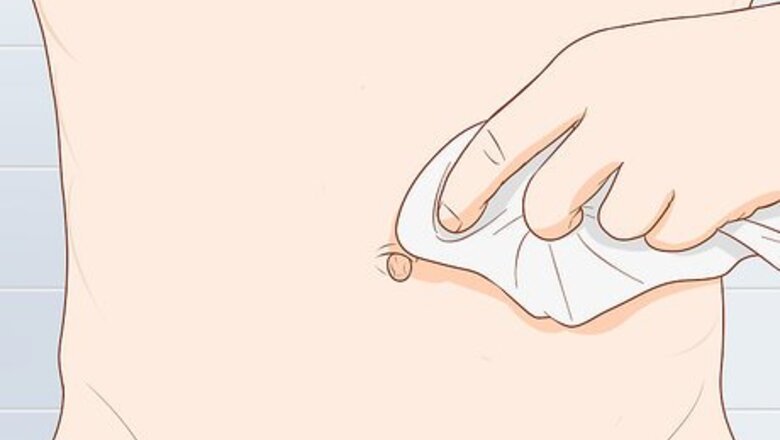
views
Creating a Regular Cleansing Routine
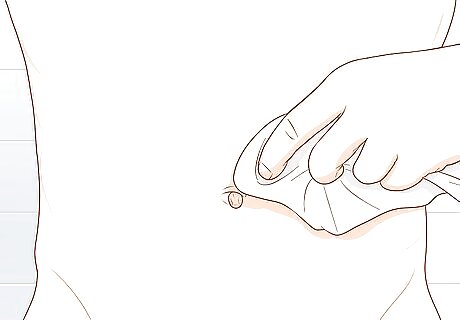
Wash your belly button whenever you shower. The best time to clean your belly button is during a regular bath or shower. Make an effort to include your belly button in your daily washing routine. You may need to wash your belly button more frequently if you’ve been sweating a lot (e.g., after exercise or when the weather is hot).
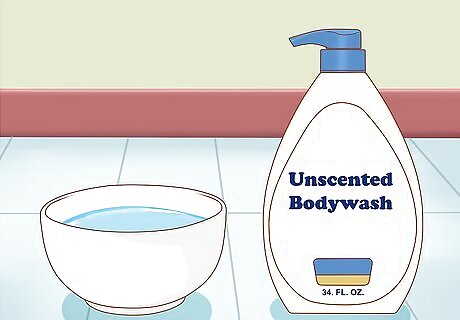
Use plain soap and water for routine washing. You don’t need anything fancy to wash your navel. Warm water and gentle soap will do the trick just fine! Apply some soap and water to your fingers or a washcloth and gently rub it into your belly button to get rid of dirt, grime, and lint. When you’re done, carefully rinse away all the suds.Tip: If your belly button is pierced, you’ll need to take special care to keep it clean. Use a warm saltwater solution to clean the area around the piercing at least 2-3 times a day, or as often as your piercing artist or doctor recommends. Belly button piercings can take a long time to heal, so you may need to keep up this routine for several months or up to a year. In general, the soap or cleanser you use for the rest of your body should work fine for your belly button. Use a gentle, unscented soap or bodywash if scented soaps cause drying or irritation. You can also use saltwater to gently cleanse your belly button. Mix 1 teaspoon (about 6 g) of table salt with 1 cup (240 mL) of warm water and dip a washcloth in the solution. Carefully massage the saltwater into your navel, then rinse it away with plain water. Saltwater can kill germs and loosen dirt, and you may find it less drying and irritating than soap.
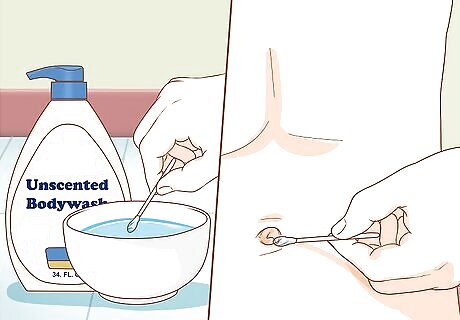
Deep-clean an innie with a washcloth or cotton swab. It’s easy for dirt and lint to build up in a deep belly button—and it can be challenging to get it out! If you have an innie, you may need to use a washcloth or a cotton swab to get inside and do a thorough cleaning. Swab out the inside of your belly button gently with soap and water, and make sure to rinse it well afterward. Don’t scrub hard—you could irritate the delicate skin in and around your belly button.
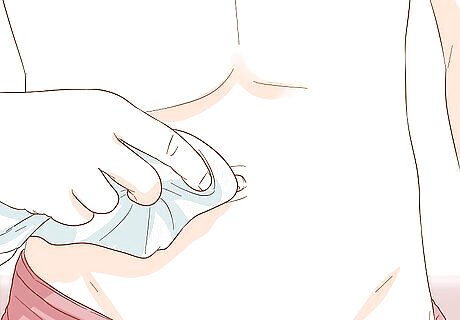
Pat your belly button dry when you’re done. It’s important to keep your belly button dry to prevent an overgrowth of bacteria and fungus. Once you’re done washing up, use a clean, dry towel to gently dry the area in and around your belly button. If you have time, you can also let it air-dry for a few minutes before putting on clothing. You can keep moisture from building up in your belly button by dressing in cool, loose clothing when the weather is warm or any time you might break a sweat.

Avoid using oils, creams, or lotions in your belly button. Don’t use any creams or lotions in your belly button unless your doctor recommends it. Doing so could trap moisture inside your belly button, creating a good environment for unwanted bacteria, fungus, or yeast. You may be able to safely moisturize your belly button with a little baby oil or light moisturizing lotion if you have an outie rather than an innie. Stop using moisturizer if you experience bad odors, itching and irritation, or other signs of infection.
Dealing with Persistent Belly Button Odors
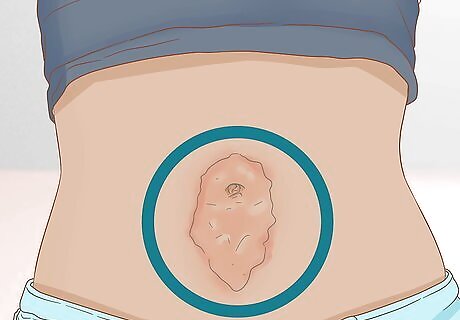
Look for signs of infection if regular washing doesn’t work. The most common cause for unpleasant belly button odors is dirt and sweat. In most cases, washing up with a little soap and water will clear up any unwanted smells. If it doesn’t, you might have an infection. Look for symptoms such as:Warning: Infections are more likely if you have a belly button piercing. If you have a piercing, look out for signs of infection such as increasing pain or tenderness, swelling, redness, warmth around the piercing, or pus. Scaly red skin Tenderness or swelling in or around your belly button Itching Yellow or green fluid or pus leaking from your belly button Fever or general feelings of illness or fatigue
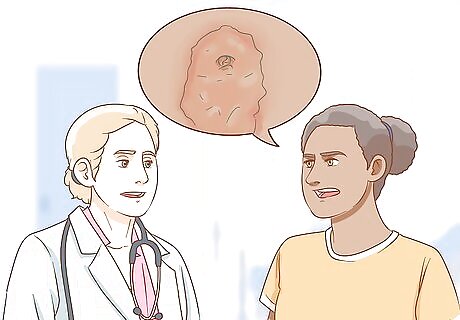
See your doctor for a diagnosis if you have infection symptoms. If you think you have an infection, make an appointment with your doctor right away. They can evaluate what kind of infection you have and tell you how to treat it properly. The appropriate treatment will be different depending on whether your infection is caused by bacteria, fungus, or yeast. Don’t try to guess what kind of infection you have, since using the wrong treatment could do more harm than good. Your doctor may swab your belly button to get a sample for testing. This can help them determine what’s causing your infection.
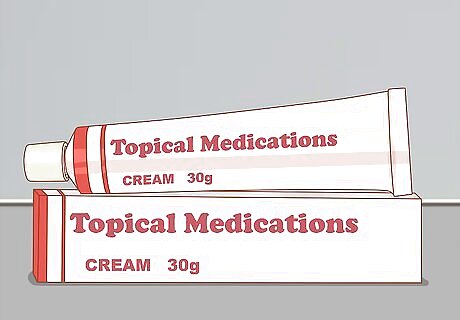
Use topical medications to treat a bacterial, fungal, or yeast infection. If it turns out you have an infection in your belly button, you may need to use an antibiotic or antifungal ointment or powder for a while to clear it up. Your doctor may prescribe medication or instruct you to buy one over-the-counter. Treating the infection should also get rid of any nasty odors or discharge! Follow any other home care instructions your doctor may have, such as: Resisting the urge to scratch or pick at your infected belly button Changing and washing your bedsheets and clothing regularly to prevent reinfection Avoiding sharing towels with other people Wearing loose, comfortable clothing to help keep your belly button cool and dry Cleansing your belly button daily with a saltwater solution
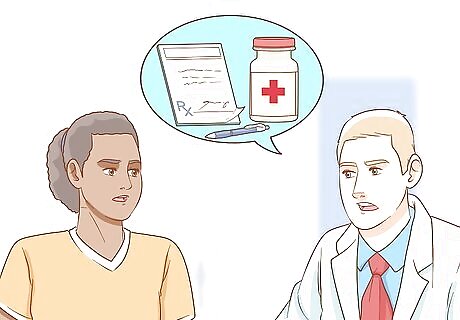
Ask your doctor to drain a belly button cyst if you have one. Sometimes a cyst can form in your belly button, potentially leading to swelling, pain, and bad-smelling discharge. If you have an infected cyst in your belly button, your doctor will probably drain the cyst in their office. They may also prescribe oral or topical antibiotics to help clear up the infection. Follow their home care instructions to help the cyst heal properly. Ask your doctor for detailed instructions on how to clean and care for your cyst at home. They may recommend putting a warm, dry compress over the area 3-4 times a day. If they applied a dressing, you will need to change it at least once a day until your doctor says you can stop using it. If your doctor packed the cyst with gauze, you’ll need to return to have it removed after 2 days. Wash the wound with warm water once a day until it heals (usually within 5 days). If the cyst comes back, you might need to have surgery to remove it completely. For deep cysts, such as urachal cysts, the surgeon will probably make a tiny incision and remove the cyst using delicate instruments, guided by a camera. You will likely need to stay in the hospital for 2-3 days after the surgery, and should be able to return to your regular activities in about 2 weeks.

Visit your doctor to get navel stones removed if necessary. If you have a deep belly button and don’t clean it often enough, dirt, lint, and oils can build up inside it. Eventually, these materials can form a hardened mass, called an omphalith or navel stone. If this happens to you, make an appointment with your doctor. They can use forceps to gently pull out the stone. In many cases, navel stones don’t cause any symptoms. Sometimes, however, they can cause sores and infections to develop. You can prevent navel stones by cleaning your belly button regularly with soap and water.


















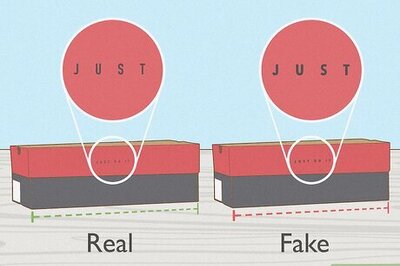
Comments
0 comment